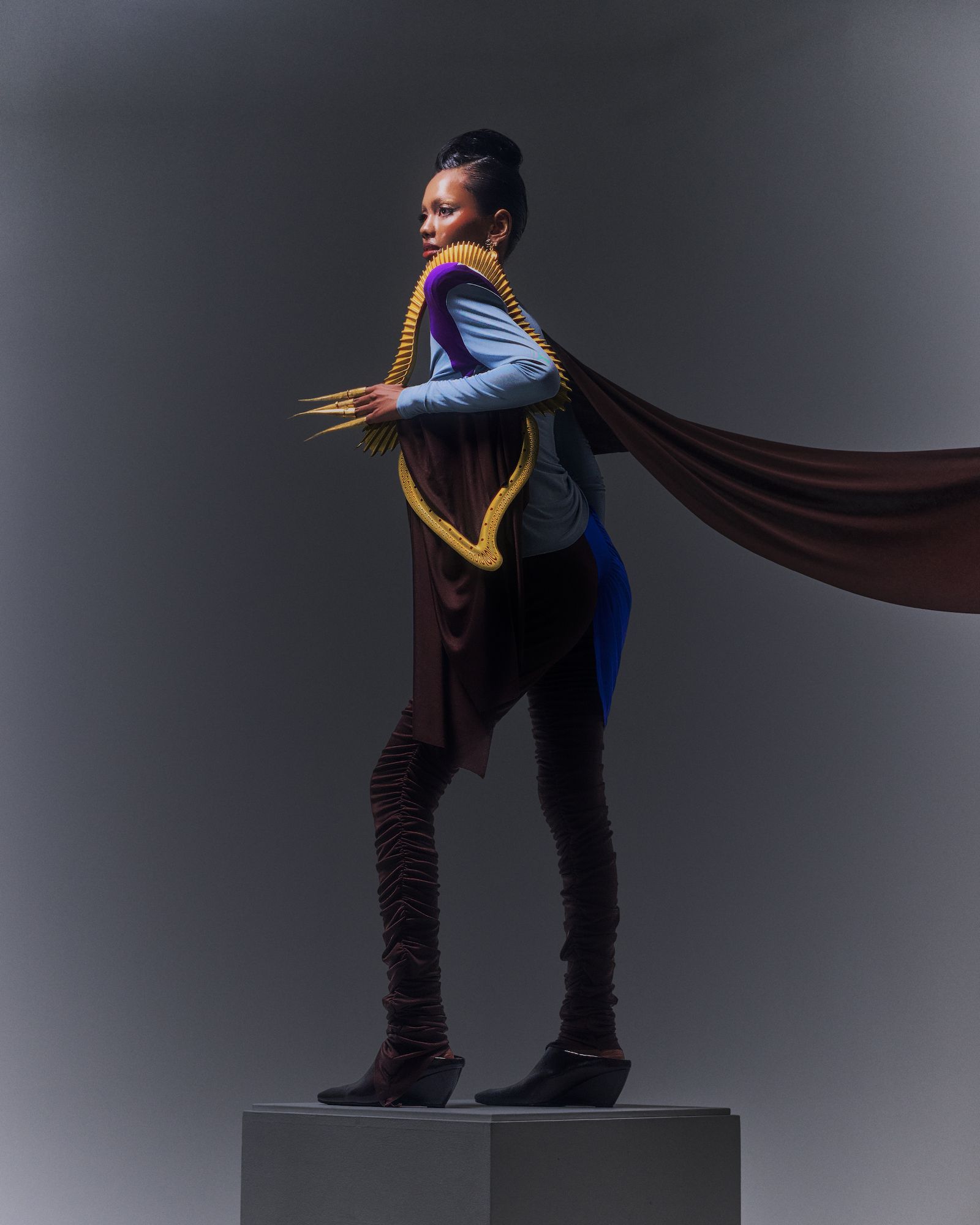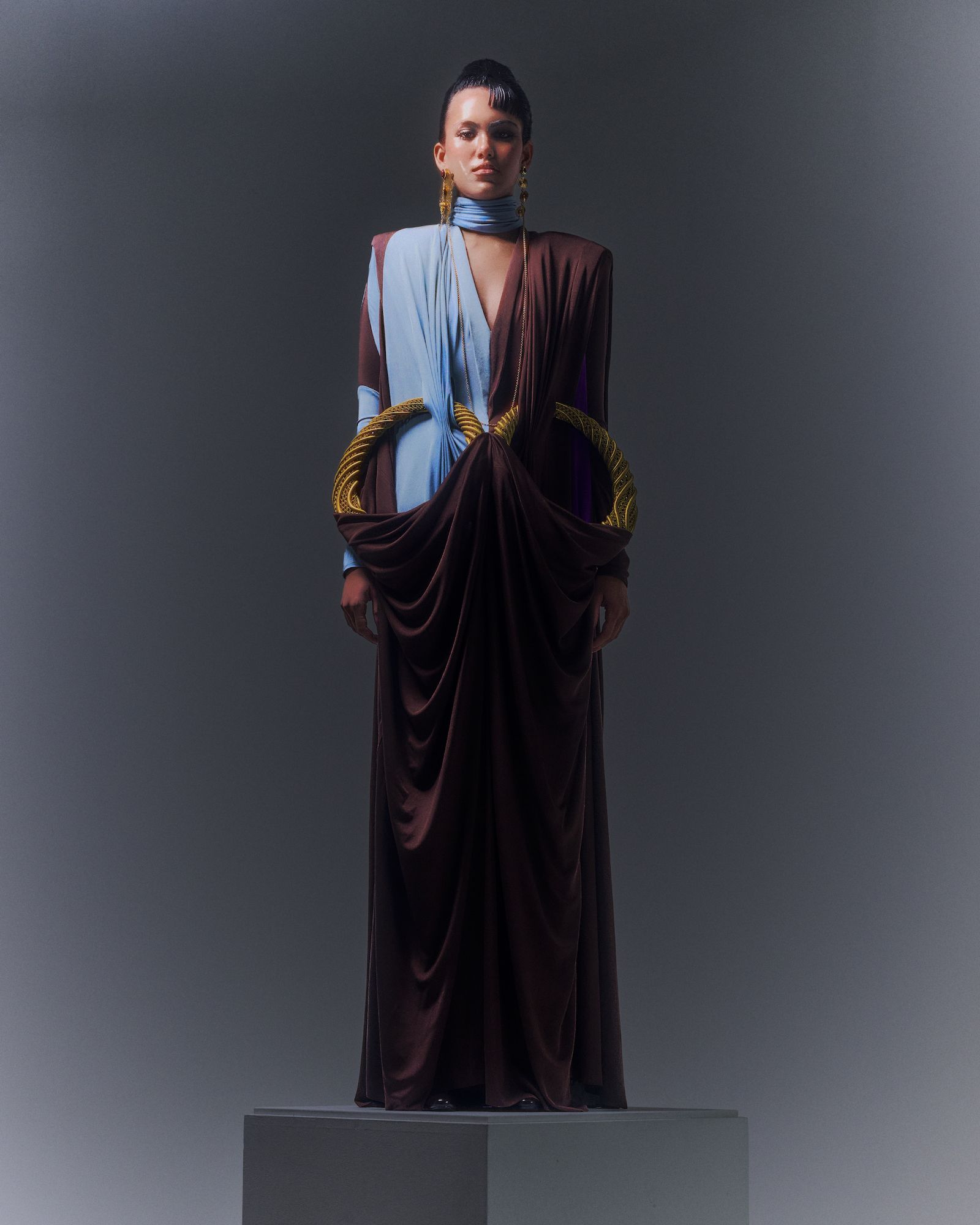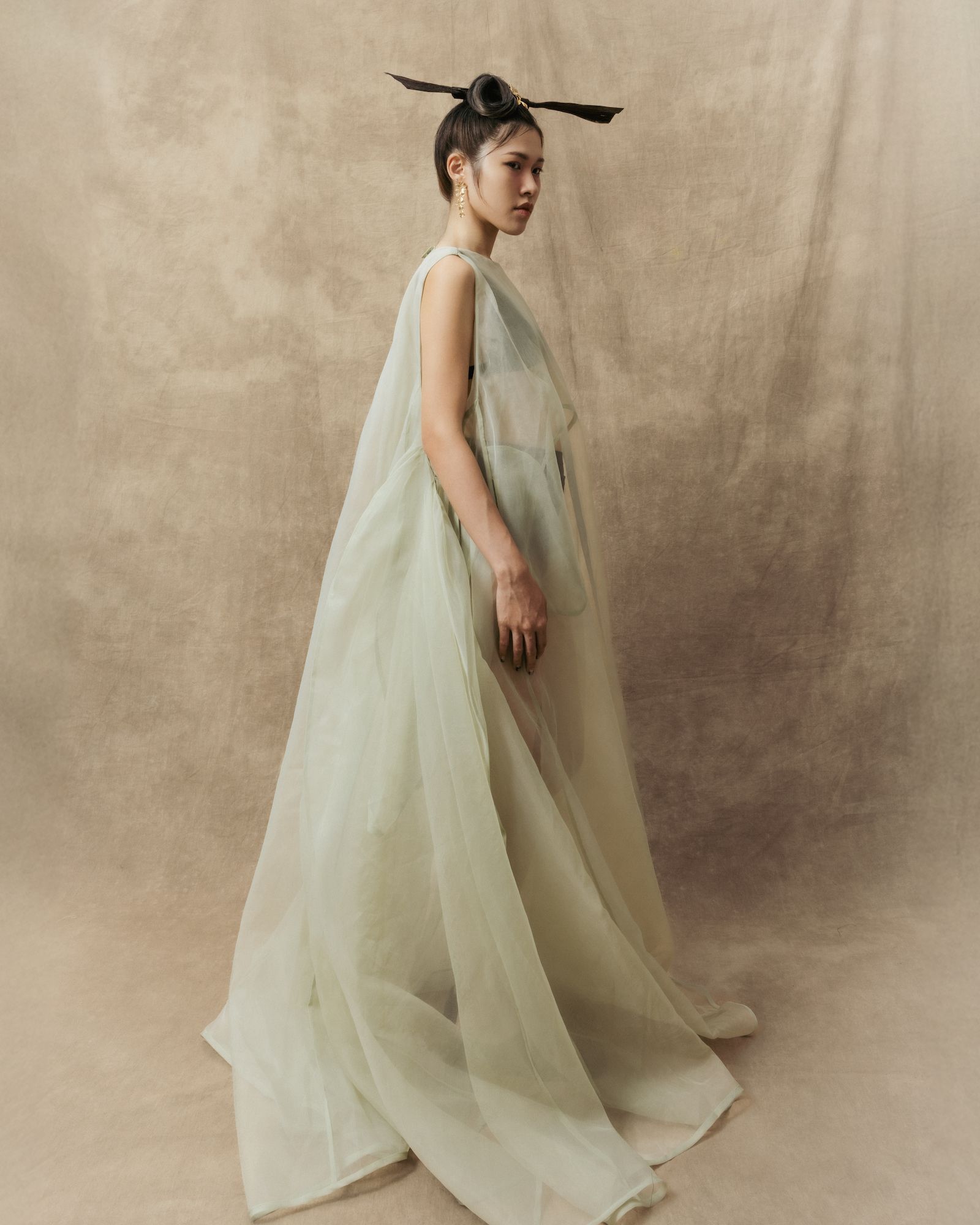
How will Singapore’s next-gen fashion designers balance modernity with heritage? At Rewoven Ties, Lasalle College of the Arts’s 2025 graduate fashion show, final-year students offered compelling answers. GRAZIA Singapore speaks to three standout designers exploring culture, craftsmanship and identity in the age of artificial intelligence.
Putri Adif

Putri Adif explores her Javanese heritage to offer Eka, a collection of colourful, draped silk jersey pieces. Her striking designs take cues from the traditional kebaya and also incorporate elements from her precious family heirlooms via 3D-printed details.
What does the name of your collection, Eka, mean?
Putri Adif (PA): “Eka” means “one” in Sanskrit, and my collection reflects the merging of the traditional and the contemporary. It was inspired by the Javanese diaspora and my ancestral heritage. It blends traditional craftsmanship with 3D printing, combining elements of the iconic kebaya with modern silhouettes and heirloom-inspired jewellery.
Tell us more about how you incorporated your family’s heirloom jewellery into your designs.
PA: A twisted gold bangle passed down from my great-great-grandmother inspired a spiral motif that runs through the entire collection. It’s reimagined as 3D-printed pieces integrated into several looks. Another heirloom—a betel nut case shaped like a pumpkin—inspired the pumpkin-shaped kerongsang (brooch) magnets used to fasten some of the garments. I opted for magnetic closures instead of pins to avoid damaging the silk jersey fabric. Because the pumpkin-shaped magnets are removable, the garments can be draped and styled in different ways, giving the wearer more freedom.
What are some noteworthy craft techniques you used in your designs?
PA: At first, I wanted the jewellery-inspired elements to be made in brass by jewellery artisans. But after much research, many of them turned me down due to the limitations of producing pieces at that scale. So I pivoted to 3D printing. Collaborating with [local fashion brand] Baëlf Design was a blessing. I learnt how computational design works—from creating the basic silhouettes of the 3D-printed objects to reimagining how they could function. [Baëlf Design co-founder] Lionel Wong helped me figure out the technical aspects, such as incorporating hinges and magnet slots.
What do you appreciate the most about Javanese culture?
PA: I appreciate its quiet strength, patience and refinement. These values shape not only daily life but also the arts. While parts of my Javanese heritage feel distant—due to time, place and circumstance—reconnecting through traditions, clothing or language feels like reclaiming pieces of myself.
Upon your graduation, what are the next steps you plan to take?
PA: I just want to keep growing as a designer and a creative. I want to stay curious. I hope that personal projects, collaborations and client work will continue to push me creatively. I also want to learn from the industry and gain more experience. Ultimately, I hope to give back to the community—because we really only have each other.
Jane Simorangkir

Jane Simorangkir expresses her punk spirit and her background as a textile artist in her collection, Destroyer Of All Things, Alchemist Of One. Drawing from themes of rebirth, destruction and mysticism, she offers an alternative vision of beauty through bold, elaborately embellished pieces that resemble armour.
Your collection is meant to offer an alternative vision of beauty. How would you describe your own relationship with beauty?
Jane Simorangkir (JS): Beauty, to me, is raw. It’s imperfect. It’s deep and layered. That’s what makes something beautiful—when there’s so much to uncover beneath the surface. Beauty is being the most honest version of yourself: uncovered, unashamed and deeply, unapologetically true.
What are some key fabrics used in your collection?
JS: I used velvet and denim. Velvet carries an ancient energy; it was once seen as royal, sacred and expensive. Denim, on the other hand, has roots in poverty, labour and struggle. That duality—the tension between what’s considered “high” and “low” by society—really spoke to me. I wanted to find oneness between those extremes. Technically, I also had to think about construction. Since the pieces are heavily embellished, they need sturdy bases. At the same time, I wanted materials that feel intimate and close to the body—tight, like second skin. Velvet is totally impractical in Singapore and that’s exactly why I chose it. I wanted it to feel like armour. As for the denim, I wasn’t trying to make it trendy. I wanted to transform it into something sacred, like a warrior’s fabric—heavily embellished, rich and protective.
What are some traditional craft techniques that you used in your designs? How did your experience as a textile artist come into play?
JS: I worked with flock and foil, as well as hand embroidery and embellishment. Flock and foil give the pieces texture, depth and irregularity—but still with a clean finish. That balance between raw and refined really clicks with my themes of duality, spirituality and oneness. Embellishment and embroidery are also big parts of my practice. I used upcycled bits—hooks, bars, eyes, random trims lying around the studio. I didn’t want to buy more materials, so I worked with whatever I had. A friend once gave me boxes of beads and I had no idea what to do with them until I envisioned a fully beaded coat—something colourful, symbolic and warrior-like. That coat ended up being about 80 per cent made from donated and found beads from friends, family and school.
Why do you think it’s important to preserve culture and traditional craft techniques, especially in this day and age?
JS: With artificial intelligence and all these tech developments, it’s not about fearing that they’ll replace craft—it’s about imagining how they might elevate it. But still, I’ve never seen a robot paint with intuition. Intuition is human. And that’s what traditional craftsmanship is. Craft is about receiving ancestral knowledge and channelling it through your hands and your spirit. It’s not just technique—it’s a feeling, a knowing, a connection.
Upon your graduation, what are the next steps you plan to take?
JS: A lot of people have asked me that and honestly, I don’t have a clear answer. I’ve been spiralling a bit—Singapore’s job market isn’t the easiest, especially for creators like me. But I just need to keep this spirit alive and trust the way I navigate things. I’ll probably apply for jobs if it feels right, and if not, I’ll look into residencies or funding and grants to set up my own studio. That’s the dream.
Jessica Christy

Jessica Christy’s collection, Xie Jia, draws inspiration from her childhood memories of sharing tea with her family—a cultural ritual during which her parents and grandparents would exchange stories and wisdom. The Chinese-Indonesian designer honours that tradition with soft tailoring, voluminous silhouettes and fluid fabrics.
How significant are tea gatherings and ceremonies in Chinese-Indonesian culture?
Jessica Christy (JC): As part of the Chinese diaspora in Indonesia, I’ve noticed that much of our cultural heritage has gradually faded. Many of us no longer speak Mandarin or our family dialects, and certain traditions have become less prominent in daily life. But the tea ceremony is one that has endured. It still plays an important role—not just in formal occasions such as weddings, but also in everyday life. Sitting down for tea with family becomes a way to slow down, reconnect and share stories. It’s one of those rituals that still ties us to our Chinese roots.
From your memories, how were people usually dressed for tea ceremonies?
JC: It really depends on the occasion and personal preference, but you’ll often see a unique blend of Chinese and Indonesian influences. My collection was inspired by the styles worn in the 1920s, when my grandparents’s families migrated from China to Indonesia. Among Chinese-Indonesians, it’s common to see a mix of attire: some wear Tang suits, others choose Western-style suits for work, and many women have embraced the kebaya encim. These stories sparked my imagination—thinking about what my great-grandparents might have worn and how their clothing choices expressed both identity and cultural fusion.
What are some key fabrics used in your collection?
JC: I mainly used wool, raw silk, silk organza and cotton voile. These are fabrics that remind me of what my mother and grandmother wore. Many of the materials are found in garments passed down through our family, which gives them a lot of sentimental value.
What are some noteworthy craft techniques you used in your designs?
JC: I designed a hidden belt loop detail below the waistband that appears like a pleat but functions to hold the belt in place, maintaining a clean, tailored silhouette. I also developed a structural sleeve inspired by the natural fold of a shirt collar—it took several iterations to achieve the fluid, effortless curve. For the oversized suit jacket, I experimented with different shoulder pad constructions and sewing methods to find the right balance between volume and a soft, relaxed shape. The exposed lapel stitching—usually concealed—is purposefully revealed to honour the slow fashion process and spotlight traditional craftsmanship.
Why do you think it’s important to preserve culture and traditional craft techniques, especially in this day and age?
JC: Culture and traditional craft techniques carry the wisdom of generations. They teach us how to live, create and connect with our identity. These techniques aren’t just skills—they’re forms of inherited knowledge that evolve with each generation. Preserving them is a way of honouring our roots while making space for reinterpretation and innovation. If they’re lost, we lose a vital part of our cultural identity—something that still holds deep relevance today. Keeping these practices alive means the stories, values and artistry of our ancestors can continue to inspire and enrich contemporary design.
This story first appeared in the August 2025 issue of GRAZIA Singapore.
READ MORE
PH5, The Fashion Brand Making Waves With Fun Knitwear, Teams Up With Charles & Keith
Chinese Fashion Designer Susan Fang Is Making The Dresses Of Her Dreams
Kitschy Couture Is The Berlin Fashion Brand Made For Romantics
